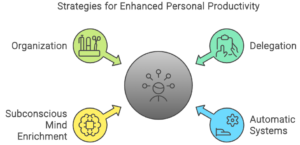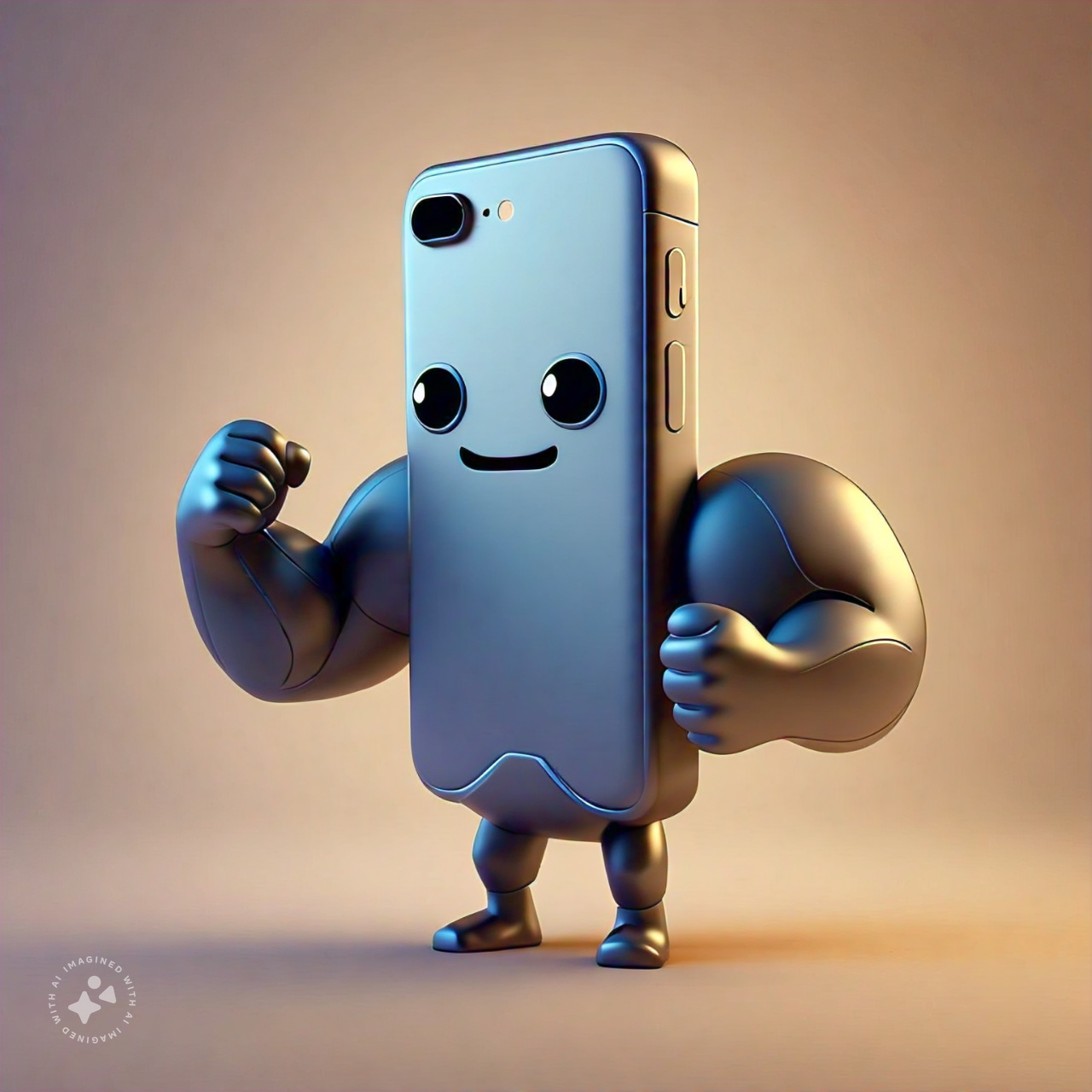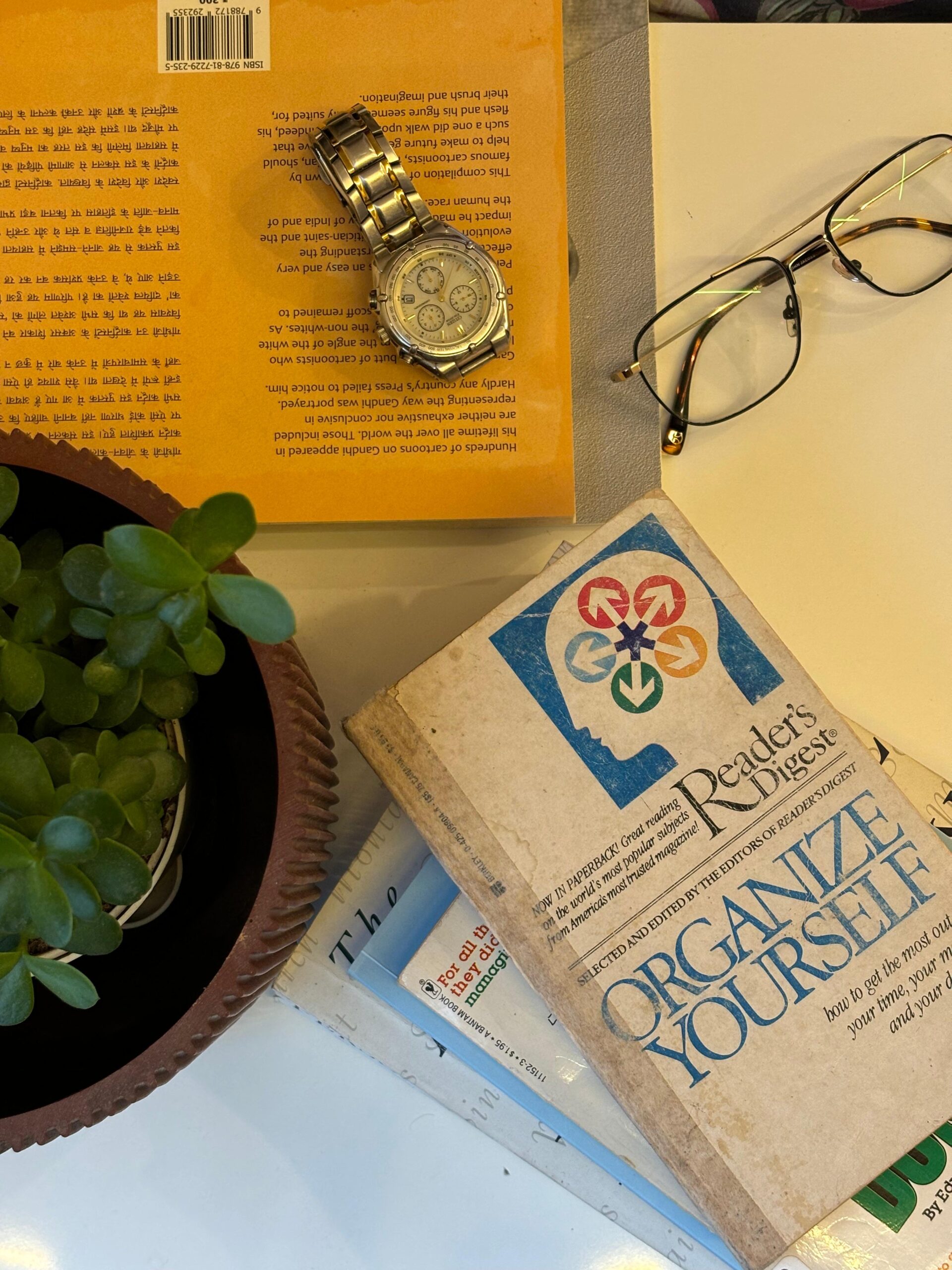The Wealth Builder’s Playbook: Let Systems and People Work for You, Not Just You
Ever wonder why the rich seem to keep getting richer while others struggle to make ends meet? The wealthy understand that accumulating wealth isn’t just about earning more money. It’s about making their money work harder and smarter. Instead of simply saving or spending, they invest in opportunities that generate additional income streams, allowing their wealth to grow exponentially. This concept of leveraging money—by investing it in assets, delegating responsibilities, and optimizing systems—is key to their success.
You can apply this same principle to personal productivity by letting systems and people (the more, the better) work for you in parallel while you focus on your core tasks. The goal is to maximize your efficiency and effectiveness by identifying delegation opportunities, strategically timing those delegations, and tracking their progress.
- Know and Track Your Delegations
Just as the wealthy invest their money at the right time to maximize returns, you need to delegate tasks at optimal times. Identify tasks that can be assigned to others and determine the best moment to delegate them. For instance, delegate routine tasks early in the day or week to ensure they are completed on schedule, freeing up your time for more impactful activities.
When we talk about delegations, it’s not just about people working directly under you. It includes anyone involved in delivering the outcomes you’re responsible for. For example, if awaiting client feedback is essential for your project, initiate that communication first thing in the morning. This keeps the feedback process moving while you handle other important tasks. Similarly, address emails that require responses while preparing a presentation so that replies may come in while you continue with other priorities.
Many of us understand the importance of delegation but often miss tracking these delegations or dependencies. Maintaining an inventory of all your delegations helps you stay on top of tasks and follow up with those who might be falling behind. Reviewing this list daily can help you optimize the benefits of their workdays.
- Identify and Create a Cohort of Automatic Systems
Look for opportunities that can enhance your productivity or advance your goals without your active involvement. For instance, consider the simple act of charging your phone. You can work comfortably while your phone charges. Identify similar opportunities where automatic systems can continue operating while you focus on more critical tasks. Automate repetitive processes, use scheduling tools, and implement productivity apps to streamline your workflow and reduce manual effort.
- Learn from How Chefs Produce Quality Dishes Just in Time
Chefs excel in time management, starting complex processes early to ensure everything comes together seamlessly. Why can’t we employ this philosophy in our day-to-day work? Often, we end up with missed tasks and last-minute delays due to a lack of comprehensive planning and organization. Chefs maintain a 100% inventory of their steps and ingredients, ensuring everything is accounted for and prepared in advance. Similarly, maintaining a complete to-do list and organizing your documents and materials meticulously can transform your efficiency. By knowing precisely what needs to be done and when, you can tackle tasks with ease and confidence, just like a chef in a well-orchestrated kitchen.
- Put Your Subconscious Mind to Work
Your mind is a powerful tool that can process information and solve problems even when you’re not actively thinking about them. Feed it with quality knowledge through books, podcasts, or videos. This continuous enrichment plants seeds that your subconscious mind can nurture, leading to insights and ideas that support your goals. Take advantage of downtime or passive learning moments to enrich your mental landscape.
Conclusion

Embracing the principles that drive wealth accumulation can significantly enhance your personal productivity. By strategically delegating tasks, harnessing the power of automatic systems, continuously feeding your subconscious mind with valuable knowledge, and staying organized, you can maximize your efficiency and effectiveness. Remember, just as the wealthy leverage their resources to grow their wealth, you too can leverage systems and people to achieve your productivity goals. Start applying these strategies today, and watch as your personal and professional success grows exponentially.
Subscribe to my newsletter, to get tips like this and more, directly in your inbox!
(Originally published in Times of India on August 31, 2024)
Navigating Your Dreams: How to Manage Multiple Goals Without Overwhelm
Many productivity experts advocate for limiting the number of goals we pursue at any given time. On the face of it the reasoning is sound—focusing on fewer objectives allows us to channel more energy and resources into each one, increasing the likelihood of success. However, for many of us, this approach isn’t always practical. Life doesn’t unfold in a series of neatly organized priorities. We often need to meet professional targets, manage family responsibilities, and find time for personal growth—all simultaneously.
Similarly, essentialism, although great in principle, ends up neglecting this practical reality. It’s often hailed as a pathway to a more focused and fulfilling life. The core idea is straightforward: by concentrating on fewer tasks or goals, we can devote more energy and resources to what truly matters, thereby achieving greater success and satisfaction. Essentialism subtly suggests that limiting our goals is always possible or practical. In reality, the need to juggle multiple priorities is unavoidable.
While the idea of limiting goals might seem appealing, the reality is that having multiple goals is often a necessity, not just a choice. Brad Stulberg, co-author of The Passion Paradox, emphasizes the importance of adding “texture” to our lives through the pursuit of diverse, meaningful activities. According to Stulberg, life’s richness and resilience come not from single-minded focus, but from engaging in a variety of pursuits that collectively contribute to our overall well-being.
Stulberg argues that this texture is what gives life its depth and meaning. Pursuing multiple goals across different domains—whether in our professional careers, personal development, family life, or hobbies—creates a tapestry of experiences that makes life both fulfilling and resilient. For example, while achieving professional success is gratifying, coupling it with personal growth, quality time with family, and hobbies leads to a more balanced and satisfying life. Each goal, though demanding, adds a unique layer to our experiences, enriching our lives in different ways.
Moreover, having multiple goals can act as a safeguard against the risks of focusing too narrowly on one area. If setbacks occur in one aspect of life—be it a career downturn, personal challenges, or a failed project—other areas can provide support and stability, preventing the loss from overwhelming us entirely. This diversification of goals helps ensure that our identity and sense of purpose are not tied to a single pursuit, making us more resilient in the face of adversity.
Additionally, having multiple goals allows us to make incremental progress toward long-term aspirations. Essentialism often overlooks the benefit of taking small, consistent steps towards future ambitions. For example, if you aspire to become an author in ten years, starting to read books on writing and studying the craft today builds a solid foundation for when you eventually focus on writing full-time. By advancing gradually in various areas, we ensure that we are not starting from scratch when the time comes to pursue our long-term goals.
In essence, pursuing a “reasonable” number of multiple goals is crucial for a rich and resilient life. Embracing diverse ambitions not only enriches our experiences but also builds resilience. By spreading our focus across various pursuits and making incremental progress, we ensure that setbacks in one area don’t derail our entire sense of purpose, allowing us to recover and thrive in other aspects of life.
The real challenge, therefore, is not about reducing our goals but about managing them effectively and ensuring they align with our core values.
This is where professional time management becomes vital. Time management isn’t just about squeezing more tasks into our day; it’s about making deliberate choices that align with our values and long-term goals. Mastering this skill allows us to juggle multiple goals effectively without feeling like we’re constantly dropping the ball.
Without a robust system to handle multiple goals, the process can quickly become overwhelming. Managing various objectives can lead to stress and chaos, particularly if there’s no clear strategy in place. The core issue is not the number of goals but the lack of a structured approach, which can result in missed deadlines and fragmented efforts.
To effectively manage multiple goals, it’s crucial to implement a structured approach. Here’s a method to alleviate the overwhelm:
- Maintain a List of Goals: Begin by clearly listing all your goals to get a high-level overview of what you aim to achieve. This list acts as a central reference point, keeping you aware of your objectives. While it’s important to have this list, remember it’s not set in stone. You can adjust and refine it as needed, but avoid making changes impulsively. Instead, ensure any modifications are deliberate and well-considered.
- Break Down Goals Using a Mind Map: Utilize a mind map to break each goal into smaller, actionable steps. This visual tool clarifies the specific actions needed for each goal, helping you to understand and prioritize tasks effectively. Don’t underestimate the importance of this step—it’s crucial for success. Many promising goals falter because we neglect to decompose them into doable actions. By investing time in this process, you ensure every necessary step is identified, reducing procrastination and facilitating progress. Remember, achieving full clarity about your goals is an ongoing process. Expect to revise your mind map multiple times as you advance and gain deeper insights.
- Create and Categorize Task Lists: Transform your mind map into detailed task lists, including all the, identified thus far, granular tasks necessary for each goal. Once you have a comprehensive list, categorize these tasks into what can be realistically achieved in the coming week and what should be placed on a back burner list.
- Use a Back Burner List: The back burner list is essential for managing overwhelm. It contains tasks that are important but not immediately actionable. By placing less urgent tasks here, you can declutter your primary task list and focus on what requires immediate attention. This approach helps maintain clarity and allows you to concentrate on tasks that are feasible within the current or upcoming week.
Organizing your goals and tasks in this manner addresses several common issues:
- Overwhelm: The back burner list mitigates the feeling of being overwhelmed by breaking tasks into manageable chunks.
- Focus: Concentrating on tasks achievable within the week ensures steady progress without spreading yourself too thin.
- Clarity: Breaking down goals into actionable steps and categorizing tasks keeps your efforts aligned and well-organized.
In essence, a trusted time management system is crucial for efficiently navigating multiple goals. By structuring your approach with clear lists, mind maps, and strategic categorization, you can handle numerous goals without succumbing to chaos. This method enables continuous progress across various pursuits while maintaining focus and reducing stress.
Don’t constrain your ambitions just to avoid diluting your focus on what seems most vital. Embrace a multitude of dreams to lead a richly textured life, as this diversity equips you to absorb setbacks and navigate challenges with resilience. By implementing a robust time management system as your backbone, you ensure that you can enjoy the journey itself, rather than viewing it as a mere series of tasks. This approach allows you to savor the process of pursuing your goals, making each step towards achievement a part of a fulfilling adventure.
Subscribe to my newsletter, to get tips like this and more, directly in your inbox!
(Originally published in Times of India on August 17, 2024)
Secrets of Everyday Apps: Enhance Your Efficiency with Hidden Features
My wife, bless her heart, isn’t the most tech-savvy person. She has been a homemaker and, even otherwise, stayed away from computers, considering them esoteric objects that she had nothing to do with. But when smartphones came in, she had to reluctantly adapt to the technology and get into the whole mumbo jumbo of the app world—app, tap, long press, three dots, etc. Now, she can barely do what she requires to do, and for anything new, she summons one of us. She often marvels at how the rest of us already know these things. Good question!
There was once a time when users had to learn software apps by going through the user documentation, which most people hated. Thus, newer apps have focused on intuitive design and in-app tutorials rather than extensive user manuals. Derogatory phrases such as RTFM are passé, and people take pride in coming up with software that does not require documentation to start using it.
In the early days of software development, we often discussed the concept of object-action vs. action-object.
Object-Action Approach: This approach starts with the object you want to interact with. For instance, in your email app, you first select an email (the object) and then choose what action you want to perform (reply, forward, delete).
Action-Object Approach: This approach begins with the action you want to take. For example, in a photo editing app, you might select “edit” first (the action) and then choose the specific photo you want to modify (the object).
The idea of tap and long press has become second nature to all mobile app users now. Once you grasp these basic cues, you can explore and master any app on your own.
Although most of us are reasonably tech-savvy, we too reach a stage of complacency and stop exploring once we know most features that we think we wish to know. That leaves some money on the table. As apps continue to evolve, they are becoming increasingly feature-rich. Ignoring these features means missing out on tools that can make your tasks faster and more efficient. By not exploiting these functionalities, you risk doing things too slowly or too poorly. To stay ahead, it’s essential to be proactive in exploring and understanding the full capabilities of the apps you use. Here’s why it’s crucial to uncover these hidden gems in the apps you use every day:
Enhanced Efficiency –
Whether it’s your messaging app, e-reader, or banking app, each one is designed to streamline your tasks with various productivity-enhancing features. We should make the most of these features to boost our efficiency.
Let me give an example. The other day my brother mentioned that Audible comes with a downside that he misses the illustrations from the book. When I mentioned to him that the Audible App provides the necessary downloads, he was pleasantly surprised. So is the power of knowing interesting features of our Apps. I was also excited once to know that I could bookmark and take notes in the audible book.
I always loved stickers in WhatsApp for conveying your emotions far better than their poor cousins, the emojis. With stickers, you don’t have to be limited by the pack of emojis that are made available to you. Stickers often have a transparent background that enhances their visual appeal. I loved creating stickers of my own from pictures that I liked. I even installed dedicated Apps to make stickers from pictures. Recently while placing a sticker, I noticed that WhatsApp allowed to make the stickers in the app itself. That saved the time and resources on my phone that I needed to make custom stickers.
Customization and Personalization –
Many apps offer settings and options that allow you to customize your experience. Kindle, for example, has features like adjusting the font size and style. These customizations can make your app usage more pleasant and tailored to your preferences.
I encountered an issue with the Teams app due to the time difference between me in India and my colleagues in the USA. Occasionally, someone would accidentally start a group call. While it was a minor inconvenience for them, it disrupted my sleep at 3 AM. I hesitated to put my phone on silent because I wanted to be reachable for emergencies. However, I discovered a useful feature in Teams called “Quiet Time,” which blocks all notifications during specified hours. Since then, I’ve been able to sleep undisturbed and only become aware of any accidental calls in the morning.
Automation and Time-Saving –
Banking apps often come with automation features that can save you a lot of time. Setting up automatic bill payments, creating budget trackers, and using mobile check deposits are just a few examples. These features help you manage your finances more efficiently without manual intervention.
How to Discover Hidden Features
To uncover hidden features in any app you use, more than the procedure, consciously doing it consistently is more important. Nevertheless, let’s see some quick tips:
- Dive into the Settings Menu: The settings menu is often a treasure trove of features. Spend some time navigating through it to discover customization options, advanced settings, and additional tools that can enhance your app experience. Try Gmail settings if you haven’t tried before. You will find tonnes of features which are not enabled by default.
- Follow Updates and Release Notes: App developers frequently roll out updates with new features and improvements. Keep an eye on release notes and update notifications to stay informed about the latest additions to your apps.
- Stay Curious: Always stay curious and explore new features and functionalities. Take some time to browse through all the menu options and don’t hesitate to try them out.
- Use ChatGPT: If you’re looking for specific functionality in your app, try consulting ChatGPT or your preferred GenAI tool. You’ll often find a way to achieve what you need within the app.
Conclusion: The Power of Exploration
In the digital age, apps are powerful tools that can significantly boost our productivity. However, their true potential lies in the features that often go unnoticed. By taking the time to explore and utilize these hidden functionalities, you can transform your app experience, making it more efficient, engaging, and tailored to your needs.
So, the next time you open WhatsApp, Audible, Kindle, your banking app, or any other app you use daily, remember to dig a little deeper. You might just uncover a feature that takes your productivity to the next level. Happy exploring!
Subscribe to my newsletter, to get tips like this and more, directly in your inbox!
(Originally published in Times of India on July 31, 2024)
How to Take Care of Your Health While Setting New Productivity Records – Part 2: The Art of Restorative Breaks
In the first part of this series, we explored how incorporating stretching and physical exercises into your daily routine can mitigate the health risks associated with prolonged sitting.
Now, let’s dive into another crucial aspect of maintaining your health while working hard: taking restorative breaks. This isn’t just about stopping work for a few minutes; it’s about engaging in activities that genuinely refresh your mind and body. One such activity is the Dutch concept of niksen.
Before we go any further, here’s a disclaimer: I’m not a health expert. What I share is based on my personal experience and common sense. This is a journey, and I hope to discover more helpful ideas as I progress.
The Importance of Restorative Breaks
It’s easy to get caught up in the demands of work and forget to take breaks. However, skipping breaks can lead to burnout, decreased productivity, and various health issues. Restorative breaks help to reset your mind, reduce stress, and improve overall well-being. They are essential for sustaining high levels of productivity over the long term.
When you’re deeply engrossed in a task, taking a break can feel disruptive. However, stepping away can actually help solidify your thoughts, offer new perspectives, and more than anything, it contributes to better overall health by reducing stress and preventing burnout.
What is Niksen?
Niksen is a Dutch term that translates to “doing nothing.” It’s the practice of purposefully taking time to be idle and letting your mind wander. This might sound counterproductive, but niksen can have significant benefits for your mental and physical health.
How to Practice Niksen
1. Find Time: Make time for spontaneous sessions of niksen throughout your day. Do not plan! Instead, seize the moment when you feel the need to unwind. The ideal time to take a break is when transitioning from one task to another. This provides a natural memo for a break, allowing your brain to shift gears more smoothly and efficiently. Use this transition time for niksen.
2. Find a Comfortable Space: Choose a quiet and comfortable place where you can relax without distractions. This could be a cozy corner in your home, a park bench, or even your office chair. Personally, I find my balcony to be an ideal spot for unwinding.
3. Let Your Mind Wander: Allow yourself to daydream, observe your surroundings, or simply breathe deeply. The goal is NOT to focus on any particular task or worry about productivity.
DOs & DON’Ts
- You DO NOT look at phone or read a book or watch TV.
- Slowly sipping water during niksen can be both refreshing and calming.
- Perform eye exercises to reduce eye strain, especially if you spend long hours staring at a computer screen. Roll your eyes, look at distant objects, and blink frequently to keep your eyes healthy.
Other Forms of Restorative Breaks
While niksen is simple and wonderful way to recharge, there are other restorative activities you can incorporate into your breaks:
- Power Naps: A short nap of 10-20 minutes can significantly boost your alertness and performance. If you nap at your desk, it’s easier to avoid sleeping too long. If you use a bed, set an alarm to ensure you wake up on time.
- Short Walks: Take a brisk walk around your office or home. Walking not only helps to stretch your legs but also clears your mind and boosts creativity. Plus, you can get a healthy dose of vitamin D, if you step out!
- Shavasana, is a fundamental yoga practice aimed at achieving deep relaxation and mental clarity. By lying flat on your back with arms and legs comfortably spread, you allow your body and mind to enter a state of complete rest, promoting stress relief and overall well-being.
- Mindful Breathing: Spend a few minutes focusing on your breath. Practice your favorite Pranayama technique; mine is Anulom Vilom. If you haven’t practiced Pranayama before, you may want to start with simpler techniques. I recently read and tried the ideas mentioned by Olsen and found them very effective. You can check out his insights here:
- Quick Meditations: Use a meditation app to guide you through a short session. Even five minutes of meditation can have a profound impact on your mental clarity and emotional balance.
Remember, investing in your health pays off best through small, consistent, long-term habits—much like compound interest—rather than seeking immediate, jackpot-like results.
Taking restorative breaks, including practicing niksen, can transform your workday and enhance your overall well-being. By giving yourself permission to pause and recharge, you’ll be better equipped to handle the demands of work and maintain your health.
Epilogue
I was amused by a TV commercial for a soft drink where a lazy guy is idling around, and another guy tries to persuade him to go do some work. The lazy guy asks why he should bother, and the other replies that it will make him rich and successful. When he asks what will happen if he becomes rich and successful, the answer is that he will be able to relax and enjoy life. The lazy guy shuts the other up by asking, “What do you think I’m doing now?”
This story humorously contrasts idleness without work with idleness after a lot of work. The key difference is the achievements made along the way. By being organized and productive, we gain control of our time, giving us the power to choose how to spend it. This power helps us stay productive while also finding ways to relax, promoting healthier, sustainable productivity. So, don’t be ashamed of relaxing or taking breaks—they are essential for long-term success.
Subscribe to my newsletter, to get tips like this and more, directly in your inbox!
Rediscovering Edwin C. Bliss: A Journey Through Time and Wisdom
Moving from the bustling streets of Mumbai to the serene city of Pune, I recently stumbled upon a hidden gem from my past. While packing, I unearthed an old Reader’s Digest book that I had bought during my student days in the 1990s from a Sunday street sale in Mumbai. The book, focused on “organizing yourself,” brought back memories of my long-standing interest in productivity.
As I began to reread this book, I turned to the acknowledgments page and noticed an article sourced from a book called “Getting Things Done” by Edwin C. Bliss. This discovery was surprising, as the title “Getting Things Done” has always been synonymous with David Allen. Intrigued, I read the article and was captivated by its insights. Determined to find the original book, I searched Amazon.in to no avail but eventually found a used copy on Amazon.com for $1, plus $6 for shipping. After a long wait, the book arrived, and it was a pleasant surprise to find it brimming with rich ideas. It’s evident that some of these ideas may have influenced David Allen’s work.
As a tribute to Edwin C. Bliss, this year, I decided to share 17 of his quotes on LinkedIn and other social media platforms. Here is that compilation for you:
17 Timeless Quotes from Edwin C. Bliss on Productivity and Time Management
- No
- “Of all the time-saving techniques ever developed, perhaps the most effective is the frequent use of the word no.”
- Planning
- “There is no more productive use of time than planning ahead.”
- Procrastination
- “Divide and conquer applies to tasks just as it does to armies or enemies.”
- Communication
- “A frequent cause of time waste is a lack of clear, direct, germane communication between people.”
- Bottleneck
- “Keep in mind that to get anything done in this world, you often must be willing to be a bit obnoxious.”
- Crisis
- “Failure to start early enough is only one cause of crises.”
- Health
- “If you find time for watching television but not for tennis or golf or jogging, you are violating the most basic rule of time management, which is to do the most important things first.”
- Break
- “You should not think of a restorative break as poor use of time. Not only will being refreshed increase your efficiency, but relieving tension will benefit your health. Anything that contributes to health is good time management.”
- Fun
- “Work is fun only when you have it under control, and leisure is fun only when you can relax without feeling guilty, knowing that you’ve earned a good rest.”
- Crisis
- “Whenever you are faced with a crisis, ask yourself, What can I do to prevent this crisis from recurring?”
- If Only
- “There is no greater waste of time than regret.”
- Siesta
- “A siesta isn’t for everyone, but if you’re one of those who perk up after one, do your darndest to arrange your schedule accordingly.”
- Prime Time
- “The best time of the day should be spent on the things that matter most, the things that require top energy, complete alertness, greatest creativity.”
- Efficiency versus Effectiveness
- “Sound time management involves thinking in terms of effectiveness first and efficiency second.”
- Office Bag
- “The only justification for taking your briefcase (office bag) home every evening is that you intend to use it the following morning for transporting your lunch.”
- Scheduling
- “Allocate blocks of time to the one or two really important things you must get done during the day, and leave plenty of unscheduled time for visitors, phone calls, unforeseen emergencies, and secondary tasks.”
- Perfectionism
- “There is a difference between striving for excellence and striving for perfection. The first is attainable, gratifying, and healthy. The second is unattainable, frustrating, and neurotic.”
In addition to these insightful quotes, another treat from Edwin Bliss is an audiobook available thanks to Simon & Schuster. I could only get it on my Amazon.com Audible account, but it was so refreshing. This engaging, conversational book offers practical advice on how to fix procrastination. If this topic interests you, I highly recommend giving it a listen.
Revisiting Edwin C. Bliss’s wisdom has been a rewarding journey. His timeless insights continue to inspire and guide us in our quest for better time management and productivity. Whether you are seeking to eliminate procrastination, improve your planning, or balance work and leisure, Bliss’s principles provide valuable guidance for enhancing efficiency and effectiveness in both your professional and personal life.
Subscribe to my newsletter, to get tips like this and more, directly in your inbox!
How to take care of your health while you are busy setting new records of productivity – 1
Prologue
After reading my ideas on enhancing personal productivity, one of my long-time associates sent me a message: “You should write something on avoiding cervical spondylitis and better sitting positions—common problems we are facing.” My first thought was, “Come on, I am not an ergonomist.” But then I understood his perspective.
Talking solely about productivity is like promoting an industry without addressing the environmental risks or suggesting ways to mitigate them. To take a more contemporary example, it’s like launching a cryptocurrency without a plan to reduce energy consumption.
So, I gave him a more reassuring response: “OK. Let me see how to tie some of these to what I know.” And that’s the spirit behind this write-up.
Motivation
If you are still not convinced about you need to do something about your health along with the sedentary work, let me advise a powerful video that I saw few years ago. It’s a very impactful video by Markus Rothkranz on the health hazards of a sedentary lifestyle. While some of his claims might be debatable, the core message is clear: We are harming our health when we remain sedentary, like sitting in front of a computer for extended periods.
But work needs to get done, and we need to be in front of a computer for that. So, here are some ideas I employ to mitigate these ill effects and stay productive while maintaining good health. Of course, I’m not a health expert, and I share this based on my experience and common sense. This is a journey, and I hope to discover more helpful ideas as I progress.
Physical Exercises
These exercises take very little time but are highly effective in mitigating the damage caused by prolonged sitting.
- Lower Back and Leg Stretches – Long periods of sitting affect the lower back and legs. I found this video by Tone and Tighten very useful for controlling back pain. (6 minutes)
- Neck Exercises – Tone and Tighten also provides a great set of neck exercises. (6 minutes)
- Static Stretches – Static stretches involve adopting and holding a position that stretches a muscle or group of muscles. This video from Harvard Medical School offers a comprehensive set of static stretches. (6 minutes)
- Dynamic Stretches – Dynamic stretches typically take specific muscles and joints through their normal range of motion, loosening up the joints and stretching the muscles. This video from Harvard Medical School provides a thorough set of dynamic stretches. (6 minutes)
Including these exercises, which take just about 20 minutes in total, in your daily routine will keep your body flexible and prepared for the perennial onslaught of work.
Pro tip: It’s not an all-or-nothing matter. Don’t feel overwhelmed by trying to do all four exercises right away. Start with your favorite one, then gradually incorporate the others as you feel comfortable. Remember, something is always better than nothing. More often than not, you’ll find yourself completing all of them, but even if you don’t, every bit helps. A wonderful addition would be to include weight training, cardio, or swimming sessions three days a week.
Let’s talk about another interesting and vital exercise in the next post in this series.
Subscribe to my newsletter, to get tips like this and more, directly in your inbox!







